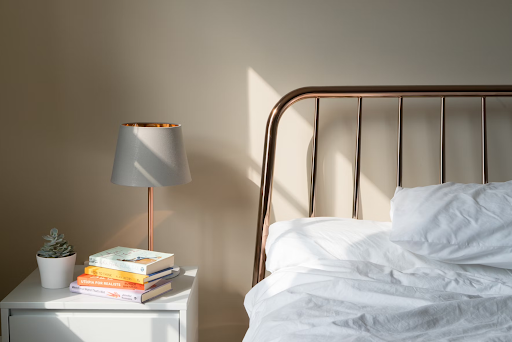How to wash your pillows

Author: Jonathan Warren
-1.jpg)
The pillows we rest our heads upon every night play an important role in our sleep quality and overall well-being. However, over time, pillows naturally accumulate a mixture of sweat, oils, dust, and allergens that not only affect their freshness but consequently, our sleep.
In this comprehensive guide, we’ll delve into the best ways to wash pillows, so you can enjoy a consistently comfortable and hygienic sleep routine. From identifying when your pillows could benefit from a wash to choosing the right washing method and drying techniques, we’ve got you covered.
Signs that your pillows need washing
If you’re changing your bedsheets and notice that your pillows don’t look as bright as when you first purchased them or that they’ve developed an usual smell, a trip to the washing machine might be in order. Whilst it’s not always easy to pinpoint the exact cause, there are some telltale signs to look out for.
Discoloration
First up is a yellowing of your pillows, also known as discoloration. We spend so much of our lives in bed and as a result, biofluids such as saliva and sweat as well as everyday products like skincare can seep into the layers of our pillows without us always noticing until they begin to change colour.
Odour
Similarly, as our bodies excrete oils, if you’ve found there to be an unpleasant smell surrounding your pillows, that could be an indicator that body odour or certain types of bacteria has permeated through the outer layers, and therefore your pillows will need a refresh.
Allergy symptoms
Started to sneeze, itch, or cough more than usual at bedtime? This could be another sign that your pillows need washing. Dust particles tend to settle when they’ve been left a little too long, which can then trigger allergy symptoms, although it’s nothing a good clean can’t fix.
If you are susceptible to allergies, it’s worth checking the labels on your pillows as certain types, in particular feather pillows, can cause reactions for some sleepers.
Preparation and precautions
You’ve spotted some signs that your pillows need washing, and you might now be wondering, what supplies do I need to get the job done correctly without impacting the integrity of my pillows?
It’s worth noting here that all pillows will come with care labels and instructions and these should always be checked adhered to when washing to limit any damage, but, as a general rule, the items you need to gather are:
- Your pillows, preferably in pairs
- A mild detergent
- Washing machine (on a gentle cycle)
- A bathtub or large sink (for pillows that require hand-washing)
- Tumble dryer (on a low heat)
- Towels or a washing line (for pillows that require air drying)
If your pillows contain materials such as down or synthetics, it’s highly likely that they will be washing machine safe, however, some materials such as memory foam or latex may require alternative cleaning methods such as hand-washing or spot cleaning.
For the purpose of this guide, we’ll focus on down, synthetic, and memory foam pillows.
Washing different pillow types
Your pillow-washing routine will largely depend on the type, where they lay, and how often you use them. But, as a general guide, the pillows you use on a nightly basis should be washed at least twice a year as a minimum.
That said, if your bedroom is hot and humid for extended periods, for example in the summer months, or if you allow pets to sleep on your bed, you should really consider cleaning them once every three months.
To keep on top of this, we recommend establishing a cleaning schedule so that you remain consistent with your pillow hygiene. Setting reminders ahead of time is a good idea, or lining it up with when you’re planning to wash your bedding that week can also work.
Here, you’ll find an overview of the different steps required to clean your pillows, based on your its type:
Synthetic pillows
- Step one: check labels and recommended care instructions
- Step two: remove any pillow cases and pillow protectors
- Step three: place in the washing machine in pairs, on equal sides of the drum
- Step four: add a mild detergent to the washing machine draw
- Step five: wash on either a cool or warm, gentle cycle
- Step six: check your pillows, if they still feel quite damp, run a spin cycle
- Step six: air dry on a washing line or tumble dry on a low heat
Down pillows
- Step one: check labels and recommended care instructions
- Step two: remove any pillow cases and pillow protectors
- Step three: place in the washing machine in pairs, on equal sides of the drum
- Step four: add a mild detergent into the washing machine draw
- Step five: wash on a cool, gentle cycle (warmer water can result in shrinking)
- Step six: run an extra spin cycle to ensure that all detergent is removed
- Step seven: air dry on a washing line or tumble dry on a low heat
Memory foam pillows
Memory foam pillows shouldn’t be placed in the washing machine unless stated otherwise on the care label. Instead, they should be hand-washed, as per the following guidelines:
- Step one: check labels and recommended care instructions
- Step two: remove any pillow cases and pillow protectors
- Step three: fill your bathtub or a large sink with cold water, add in a mild detergent and mix thoroughly
- Step four: submerge the pillow carefully, gently squeezing (be careful not to wring)
- Step five: remove the pillow, place on a clean towel and empty the bathtub or large sink
- Step six: refill your bathtub or large sink with cold, clean water
- Step seven: submerge the pillow for a second time, gently squeezing (be careful not to wring)
- Step eight: drain the bathtub or large sink and gently squeeze the pillow to remove all excess water
- Step nine: leave on a clean towel to air dry for up to 24 hours
Spot-cleaning small areas or delicate materials
If you’re between washes or don’t think your pillows warrant a trip to the utility room just yet, you can opt to spot clean instead, which is also a great route for delicate materials:
- Step one: check labels and recommended care instructions
- Step two: remove any pillow cases or pillow protectors
- Step three: fill a bowl with cool, soapy water
- Step four: grab a clean washcloth or towel
- Step five: submerge the washcloth or towel in the cool, soapy water
- Step six: wring out any excess water
- Step seven: blot the washcloth or towel against the areas of concern on your pillows
- Step seven: pleace the pillows on a clean surface or towel and leave to air dry
Machine-washing process
For pillows that can go into the washing machine, whether that’s down or synthetic, for optimal results, you want to place them into the drum in pairs, separated on either side, as this balances the load and limits any damage to the inner materials.
Unless stated otherwise, all pillows should be washed on a gentle cycle to maintain integrity, on either a cool (30 degrees) or warm (40 degrees) setting.
Once placed inside and the correct settings lined up, add a mild detergent into the washing machine draw as normal but pay attention to how much you’re using. Whilst your pillows will fill the drum, synthetic pillows in particular might not be as heavy in comparison to a full load of clothes. Therefore, we would recommend checking the guidance on your detergent beforehand.
For an extra boost of freshness, you can add scent boosters, but they will need to be suitable for all materials.
Drying techniques
You’ve made it this far, and you don’t want to drop the (dryer) ball here. Similarly to washing, drying guidance on your pillows needs to be reviewed ahead of placing any and all pillows into the machine.
Using a tumble dryer
Synthetic
Synthetic pillows are one of the more quicker-drying materials, therefore it’s important to make sure you’re checking them intermittently, every 20 minutes, so that they don’t overheat and cause any clumps:
- Step one: check labels and recommended care instructions
- Step two: place evenly in the tumble dryer, a pillow either side
- Step three: if you have them to hand, add a couple of dryer balls
- Step four: run the machine on a low heat
- Step five: remove from the drum and hand fluff every 20 minutes until dry
Down
The key thing to remember with down pillows is that they can be prone to shrinkage if too much heat is applied, therefore, opting for a cooler temperature should limit any damage. The process for drying down pillows is similar to that of synthetic materials:
Step one: check labels and recommended care instructions
Step two: place evenly in the tumble dryer, a pillow either side
Step three: if you have them to hand, add a couple of dryer balls
Step four: run the machine on a low heat
Step five: remove from the drum and hand fluff. If the pillow feels damp or clumpy, repeat steps two and three until dry
Memory foam
You might have guessed it - unless highlighted - memory foam pillows shouldn’t be placed in the tumble dryer as it can ruin the material and cause crumbling which will ultimately affect the quality of your sleep. Alternatively, once memory foam pillows have been washed they should be left out to air dry.
Air drying
If preferred or if you don’t have a tumble dryer at home, all pillow types can be air dried using the same technique, but it’s particularly important for memory foam pillows.
If it’s a warm day outside, they can either be pinned to the washing line and air dried, as long as you check on them every so often so they’re not left out too long. Another option is to find an airy room in the house and place your pillows on a towel to dry, preferably with the windows open. Not only do towels keep your pillows protected from surfaces, but they help to soak up moisture.
With air drying pillows, patience is key, as they tend to take longer than a tumble dryer. However, to check they’re dry, you can follow the same process highlighted above by placing them in your hands and fluffing them up. If they have an odour or feel clumpy, continue to leave them to dry before placing them back on your bed.
Maintaining pillow integrity
When going through the pillow-washing process, you want to maintain fluffiness and shape as much as possible, to aid in a fresh and comfortable sleep. That’s why using a mild detergent, gentle wash cycle, and a low drying heat really matters.
As well as this, wringing out water between the wash and drying stages, for synthetic and down materials, as well as fluffing pillows throughout the drying process will help to maintain your pillow’s structure.
To extend the lifespan of your pillows and keep them clean for longer, you should also consider:
- Regularly changing your pillow cases
- Using pillow protectors
- Flipping your pillows for even distribution
- Limiting the instances you go to sleep with wet hair
- Allowing your skincare products to dry before getting into bed
- Washing and drying them according to the care instructions
Pillow protectors
Pillow protectors are a great way to keep your pillows fresh and maintain pillow hygiene for longer. Usually placed on top of your pillow, underneath your case, the benefits of pillow protectors include:
Keeping your pillows clean
Perhaps unsurprisingly, pillow protectors are great for limiting the amount of freshening up and spot cleaning you might need to do between washes. Adding another layer, they provide a barrier for sweat, oils, and any products that might seep through.
Defending against the unwanted
Whether it’s allergies or bed bugs, pillow protectors are great for keeping out the unwanted. The extra shield helps to prevent buildup that might attract dust and mites that can trigger allergy symptoms, contributing towards a fresher, more comfortable sleep.
Extending your pillows lifespan
Along with keeping your pillows clean, protectors are also a great way to extend the lifespan of your pillows as they can help to limit any damage such as rips and tears, which then makes them harder to wash.
Adding an extra layer of comfort
We all want to wake up feeling well rested and refreshed, right? Well, in addition to all of the great hygiene benefits, pillow protectors can also add an extra layer of cosiness at bedtime, helping you to drift off comfortably.
So, now you know just how important it is to keep your pillows clean, especially when you’re striving for a better sleep routine and overall health, as well as the best ways to do so. As we prepare to step into autumn, there’s no better time to put our guide to good use…
Interested in more tips to maximise your well-being at bedtime?
You’ve come to the right place. Check out our Time4Sleep blog for the latest tips, guides, and advice on the different steps you can take to make sure sleep is the best quality it can be.



